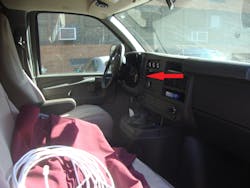Editor’s note: “Mitigating Mistakes” is a monthly SecurityInfoWatch.com column series from security consultant and author Paul Timm featuring photos of security vulnerabilities discovered in the field followed by a discussion on the problems they present to a facility’s security posture and how they can be addressed.
Finding: When conducting facility security assessments, I also inspect fleet vehicles to make sure they are secure. Occasionally, we find vehicles that are unlocked. Sometimes, we actually find keys in the ignition.
Problem: At minimum, unsecured vehicles are at risk for theft of valuable items, such as tools and electronic devices. Leaving keys in vehicles invites criminal trespass and motor vehicle theft.
Lesson: From golf carts to trucks, fleet vehicles warrant an important place in your security planning efforts.
Remedy: Develop and document effective vehicle security and key control policies. Provide instruction for designated personnel. Require all employees who operate fleet vehicles to follow vehicle security practices at all times. Routinely inspect your vehicles to ensure security practices are being followed. Consider storing fleet vehicles in secured areas, such as garages and fenced areas. If they cannot be stored in secured areas, ensure they are kept in parking areas that are well-lit and monitored by video surveillance cameras.
About the Author:
Paul Timm, Vice President of Facility Engineering Associates, is a board-certified Physical Security Professional (PSP), the author of School Security: How to Build and Strengthen a School Safety Program, and a nationally acclaimed expert in physical security. In addition to conducting numerous vulnerability assessments and his frequent keynote addresses, Paul is an experienced Crisis Assistance Team volunteer through the National Organization for Victims Assistance (NOVA). He is certified in Vulnerability Assessment Methodology (VAM) through Sandia National Laboratories and the ALPHA vulnerability assessment methodology. He is also a member of ASIS International’s School Safety & Security Council and the Illinois Association of School Business Officials’ Risk Management Committee. Paul recently earned his Master’s degree from Moody Theological Seminary.
About the Author

Paul Timm, PSP
President, RETA Security, Inc.
Paul Timm, Vice President of Facility Engineering Associates, is a board-certified Physical Security Professional (PSP), the author of School Security: How to Build and Strengthen a School Safety Program, and a nationally acclaimed expert in physical security. In addition to conducting numerous vulnerability assessments and his frequent keynote addresses, Paul is an experienced Crisis Assistance Team volunteer through the National Organization for Victims Assistance (NOVA). He is certified in Vulnerability Assessment Methodology (VAM) through Sandia National Laboratories and the ALPHA vulnerability assessment methodology. He is also a member of ASIS International’s School Safety & Security Council and the Illinois Association of School Business Officials’ Risk Management Committee. Paul recently earned his Master’s degree from Moody Theological Seminary.
